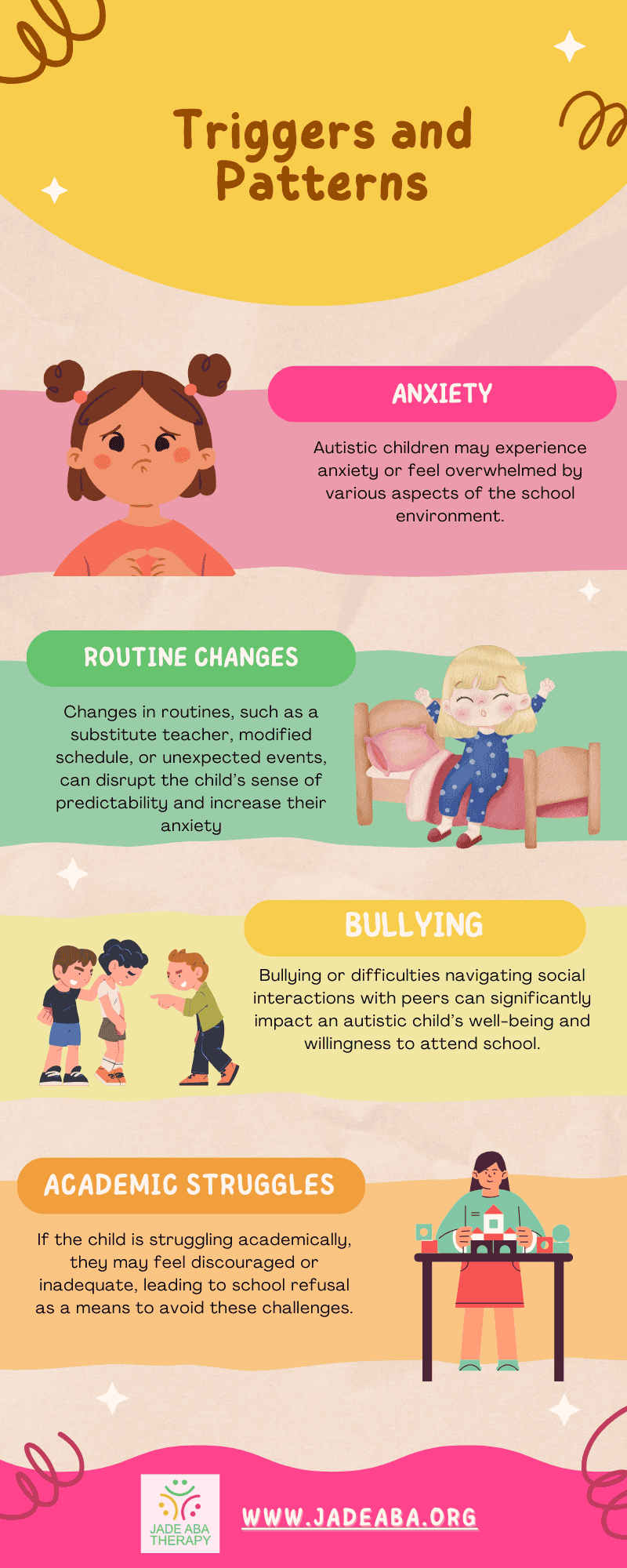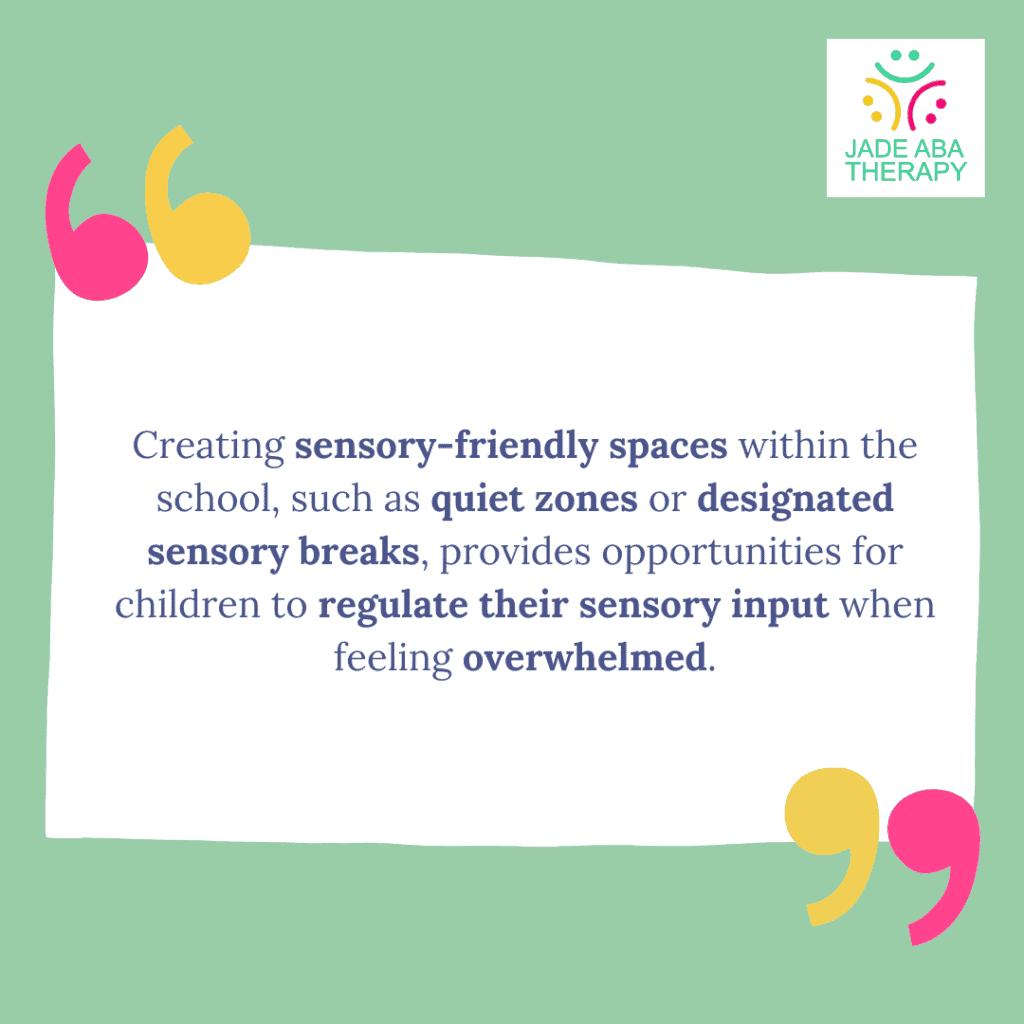For parents and educators of autistic children, navigating the complexities of schooling can present unique challenges. Among these challenges, one of the most distressing scenarios is when a child adamantly refuses to attend school. In this article, we delve into the intricacies of school refusal in autistic children and provide practical guidance for parents and educators grappling with this issue.

Challenges Faced by Autistic Children
School refusal or avoidance in autistic children can be complex and multifaceted, influenced by a myriad of factors inherent to the autistic experience. While it can be distressing for parents and educators, it’s equally important to acknowledge the distress that the autistic child themselves may be experiencing. Their reluctance, after all, can stem from a variety of sources, each deserving of careful consideration.
Communication Barriers
One significant factor contributing to school refusal in autistic children is communication barriers. Autism spectrum disorder often brings challenges in verbal and non-verbal communication, making it difficult for children to express their feelings, concerns, or discomfort about school. They may struggle to articulate their experiences or may not possess the language skills necessary to convey their emotions effectively. Consequently, parents, caregivers, and educators must seek alternative methods of communication to understand the child’s perspective.
Visual supports have proven to be invaluable tools in bridging communication gaps for autistic children. Visual schedules, social stories, and communication boards offer concrete and structured means for children to express themselves and communicate their needs. These aids provide a visual framework that enhances comprehension and reduces anxiety, empowering autistic children to navigate their school environment more confidently.
When appropriate, encouraging open lines of communication with the child’s speech therapist can also provide insightful information about the child’s communication skills and areas in need of additional support. It will facilitate the development of tailored strategies to address communication challenges specific to the child, ultimately enhancing their ability to express themselves in the school setting.
Sensory Overload and Environmental Sensitivities
Another common challenge faced by autistic children in the school environment is sensory overload and heightened sensitivities to environmental stimuli. The bustling atmosphere of classrooms, fluorescent lighting, loud noises, and unpredictable social interactions can overwhelm autistic individuals, leading to feelings of discomfort and distress. In response, some children may resort to avoidance behaviors.
Creating sensory-friendly spaces within the school, such as quiet zones or designated sensory breaks, provides opportunities for children to regulate their sensory input when feeling overwhelmed. Additionally, implementing sensory accommodations, such as noise-canceling headphones or fidget tools, empowers children to manage sensory challenges more effectively and participate fully in classroom activities.
Fostering an understanding and accepting school culture that values neurodiversity can cultivate a supportive environment where autistic children feel accepted and understood. Educating classmates and school staff about autism spectrum disorder and sensory differences promotes empathy and inclusivity, fostering positive peer relationships and reducing feelings of isolation for autistic children.
Individualized Support and Collaboration
It’s essential to recognize that each autistic child is unique, with their own set of strengths, challenges, and support needs. Therefore, a one-size-fits-all approach to addressing school refusal is inadequate. Instead, a collaborative and individualized approach involving parents, educators, therapists, and other relevant stakeholders is necessary to develop effective interventions tailored to the child’s specific needs.
Regular communication and collaboration between parents and school staff are paramount in identifying triggers for school refusal and implementing targeted support strategies. By working together, parents and educators can share valuable insights and observations, enabling them to develop comprehensive plans that address the child’s academic, social, emotional, and sensory needs.
Furthermore, involving the child in the decision-making process empowers them to take ownership of their educational experience and fosters a sense of agency and autonomy. By soliciting their input and preferences, educators can create a supportive learning environment that aligns with the child’s interests, strengths, and sensory preferences, thereby increasing their motivation and engagement in school activities.
Strategies for Support
When an autistic child refuses to go to school, it is essential to provide them with tailored support and adjustments to address their specific challenges. By understanding their individual needs and creating a supportive environment, we can help reduce school avoidance and promote a positive school experience.
Tailored Support and Adjustments
One of the key strategies is to provide tailored support and adjustments that address their unique challenges. This involves collaborating with parents, caregivers, teachers, and other school staff to identify the specific reasons behind the child’s avoidance. Regular discussions can help identify any emerging challenges and ensure that appropriate support is in place.
By understanding the underlying causes of school refusal, such as anxiety, sensory overload, or difficulties with social interactions, we can develop targeted interventions. This may include implementing individualized education plans (IEPs), providing additional support in the classroom, or offering specialized therapies like ABA therapy. These interventions should be designed to meet the child’s specific needs and help them navigate the school environment successfully.
Creating a Supportive Environment
Creating a supportive environment is another vital aspect of helping an autistic child overcome school refusal. This involves making adjustments within the school setting to accommodate their needs and reduce potential triggers. Some strategies for creating a supportive environment include:
-
- Visual supports: Using visual schedules, social stories, and visual cues can help autistic children understand expectations and navigate their daily routines more effectively. Visual supports provide predictability and can alleviate anxiety.
-
- Sensory considerations: Sensory sensitivities are common among autistic individuals. By creating a sensory-friendly environment, such as providing a quiet space or offering noise-canceling headphones, we can help minimize sensory overload and create a more comfortable school experience.
-
- Structured routines: Establishing clear and consistent routines can provide a sense of security for autistic children. Having a predictable schedule with designated times for different activities can help reduce anxiety and provide a sense of stability.
-
- Positive reinforcement: Recognizing and rewarding the child’s efforts and achievements can motivate them to engage in school activities. Positive reinforcement, such as praise or small rewards, can help reinforce positive behaviors and build confidence.
-
- Peer support: Encouraging peer interactions and fostering understanding among classmates can create a more inclusive and supportive school environment. This can be achieved through activities like peer mentoring or promoting awareness and acceptance of autism within the school community.
Therapeutic Interventions and Support
Therapeutic interventions, such as cognitive-behavioral therapy (CBT), can be effective in addressing the underlying causes of school refusal in autistic children. It focuses on identifying and modifying negative thought patterns and behaviors, helping the child navigate difficult situations and build resilience. Hopefully, it will also help children develop coping strategies, manage anxiety, and improve their overall well-being.
Signs of School Refusal
Recognizing the signs of school refusal in autistic children is crucial for understanding and addressing their needs. Autistic children may exhibit several behavioral indicators that suggest school refusal. These indicators can manifest differently in each child and may vary in intensity. It’s important to observe and identify these signs to support the child effectively.
-
- Resistance or refusal to get ready for school: The child may show resistance or refusal when it’s time to prepare for school, such as getting dressed or packing their bag.
-
- Anxiety or distress: Autistic children may exhibit signs of anxiety or distress without being able to articulate their feelings. This can include crying, tantrums, or physical symptoms like stomachaches or headaches.
-
- Escaping or eloping from school: Some children may attempt to escape or elope from school, displaying a strong desire to leave the school premises.
-
- Avoidance behaviors: The child may engage in avoidance behaviors, such as hiding, running away, or clinging to a caregiver to avoid going to school.
- Worsened symptoms during specific periods: School refusal may be more pronounced during specific periods, such as the start of a new school year, after holidays, or after a prolonged absence from school.

Triggers and Patterns
Understanding the triggers and patterns associated with school refusal can also provide valuable insights into the underlying reasons for the child’s avoidance. Autistic children may struggle to communicate what specifically causes their distress about school, adding complexity to the identification process. However, below are some common triggers that contribute to school refusal in autistic children.
-
- Anxiety or overwhelm: Autistic children may experience anxiety or feel overwhelmed by various aspects of the school environment, such as sensory stimuli, social interactions, academic demands, or transitions between activities.
-
- Difficulties with routine changes: Changes in routines, such as a substitute teacher, modified schedule, or unexpected events, can disrupt the child’s sense of predictability and increase their anxiety, leading to school refusal.
-
- Specific school-related challenges: Certain aspects of the school environment, such as crowded hallways, noisy classrooms, or unfamiliar social dynamics, can be particularly challenging for autistic children, contributing to their avoidance of school.
-
- Bullying or social difficulties: Bullying or difficulties navigating social interactions with peers can significantly impact an autistic child’s well-being and willingness to attend school.
-
- Academic struggles: If the child is struggling academically, they may feel discouraged or inadequate, leading to school refusal as a means to avoid these challenges.
Seeking Professional Help
When an autistic child refuses to go to school, seeking professional help is an important step. Professional intervention can provide valuable insights, assessments, and therapies to support both the child and their caregivers. Two key aspects to consider when seeking professional help are the importance of timely intervention and the benefits of a collaborative support network.
Importance of Timely Intervention
Timely intervention is crucial when dealing with school refusal in autistic children. Ignoring the issue or delaying intervention can lead to prolonged absence from school, making it more challenging for the child to reintegrate into the school environment. Acting promptly and sensitively can help prevent further escalation of the issue and support the child in returning to school.
Collaborative Support Network
Parents play a critical role in sharing information about their child’s needs and experiences, as they possess valuable insights into their child’s behavior and triggers. School staff, including teachers, counselors, and special education professionals, can provide valuable input regarding the child’s experiences in the school environment. Together, parents and school staff can collaborate with professionals to develop appropriate strategies and interventions.
The Takeaway
Conditions like anxiety or depression can often be associated with school refusal, and managing these conditions can significantly improve the child’s ability to attend school. Collaborating with professionals, such as special education teachers or behavior analysts, can help develop individualized behavior plans to address school refusal in autistic children.
The role of professionals and therapeutic interventions is crucial. Collaborative support from professionals, such as therapists or counselors, can play a crucial role in managing school refusal in autistic children. These professionals have the expertise to understand the unique needs and challenges of autistic individuals and can provide tailored interventions and support.
By seeking professional help and accessing therapeutic interventions and support, parents and caregivers can equip themselves with the necessary tools to effectively manage school refusal in their autistic children. Remember, each child is unique, and patience, understanding, and a multidisciplinary approach are key to helping the child overcome school refusal.
For families seeking professional support, ABA therapy in Maryland offers tailored strategies that can enhance coping skills and foster personal growth. To learn more about how Jade ABA Therapy can help, feel free to contact us today and explore the best solutions for your loved one.
Sources:
- https://raisingchildren.net.au/autism/school-play-work/school/school-refusal-autistic-children-and-teenagers#:~:text=Autistic%20children%20might%20refuse%20to,to%20help%20with%20school%20refusal.
- https://www.autism.org.uk/advice-and-guidance/topics/education/attendance-problems
- https://www.leicspart.nhs.uk/autism-space/education/support-when-an-autistic-child-finds-it-too-difficult-to-attend-school/




